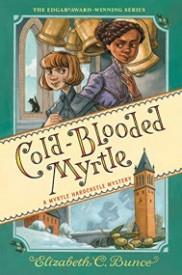
About This Book:
Myrtle Hardcastle—twelve-year-old Young Lady of Quality and Victorian amateur detective—is back on the case, solving a string of bizarre murders in her hometown of Swinburne.
When the proprietor of Leighton’s Mercantile is found dead on the morning his annual Christmas shop display is to be unveiled, it’s clear a killer had revenge in mind. But who would want to kill the local dry-goods merchant? Perhaps someone who remembers the mysterious scandal that destroyed his career as a professor and archaeologist. When the killer strikes again, each time manipulating the figures in the display to foretell the crime, Myrtle finds herself racing to uncover the long-buried facts of a cold case—and the motivations of a modern murderer.
*Review Contributed by Karen Yingling, Staff Reviewer*
Young readers frequently want murder mysteries, and not only are several townspeople dispatched in this story, there is the historical mystery of Olive as well. This causes many people in the town to be suspects, and Myrtle doesn’t spare anyone! Since British murder mysteries are popular with adults not only in novels, but also in television shows, this series is a great way to introduce younger readers to this genre. There are plenty of clues to file away and figure out, and the twists and turns end in a very satisfying way!
Readers who enjoyed mysteries like Souders’ Coop Knows the Scoop, Gray’s The Amelia Six, and the work of Stuart Gibbs will find Myrtle a great introduction to the Victorian era and a keen detective when it comes to figuring out murders!
*Find More Info & Buy This Book HERE!*



































